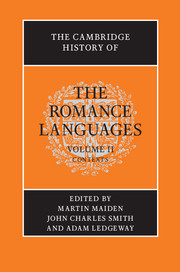Book contents
- The Cambridge History of the Romance Languages
- The Cambridge History of the Romance Languages
- Copyright page
- Dedication
- Contents
- Contributors
- Abbreviations
- Introduction
- 1 Latin and the making of the Romance languages1
- 2 The transition from Latin to the Romance languages
- 3 Periodization
- 4 Evidence and sources
- 5 Koinésandscriptae
- 6 Contact and borrowing
- 7 The Romance languages in the Renaissance and after
- 8 Geography and distribution of the Romance languages in Europe
- 9 The sociology of the Romance languages
- 10 Romance outside the Romània
- 11 Creoles
- References and bibliographical abbreviations
- Index
8 - Geography and distribution of the Romance languages in Europe
Published online by Cambridge University Press: 05 October 2013
- The Cambridge History of the Romance Languages
- The Cambridge History of the Romance Languages
- Copyright page
- Dedication
- Contents
- Contributors
- Abbreviations
- Introduction
- 1 Latin and the making of the Romance languages1
- 2 The transition from Latin to the Romance languages
- 3 Periodization
- 4 Evidence and sources
- 5 Koinésandscriptae
- 6 Contact and borrowing
- 7 The Romance languages in the Renaissance and after
- 8 Geography and distribution of the Romance languages in Europe
- 9 The sociology of the Romance languages
- 10 Romance outside the Romània
- 11 Creoles
- References and bibliographical abbreviations
- Index
Summary
- Type
- Chapter
- Information
- The Cambridge History of the Romance Languages , pp. 283 - 334Publisher: Cambridge University PressPrint publication year: 2013
- 1
- Cited by

